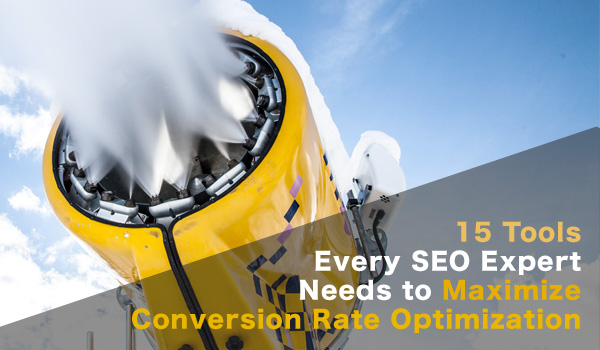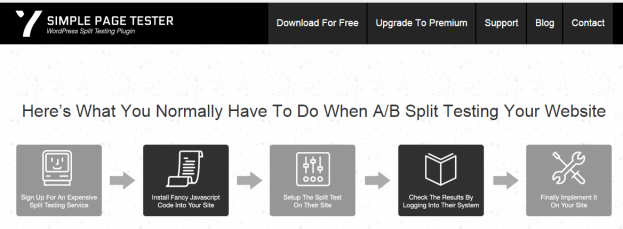15 Tools Every SEO Expert Needs to Maximize Conversion Rate Optimization
Let’s face it, you can do all the SEO in the world but if you’re not converting the visitors that land on your site from browsers to subscribers and eventually sales then you won’t make it very far.
Webmaster’s Note: This is a guest post by Daniel Ndukwu. If you’re interested in submitting a guest post, you can do so here.
Whether your chief aim is list building for future projects or funneling everyone to a sales page, you need some solid tools in your arsenal to make your job simpler and more efficient.
There are hundreds of tools on the market all claiming to do the same thing – make your life easier. While some of them deliver on their promises, a lot don’t.
I’ve assembled a list of the 15 best tools to make it a walk in the park for you to jump in and dominate without spending all your waking hours glued to a computer screen.
In addition to this list of awesome conversion rate optimization (CRO) Tools, I’ve prepared a bonus with my personal swipe file of super actionable A/B Test Case Studies at the end of this post.
But before we get into that, let’s take a look at what conversion rate optimization is and why it matters to you.
What Is Conversion Rate Optimization?
Qeryz defines conversion rate optimization as using analytics, feedback, and analytics to improve the performance of your website. A Systematic approach which allows you to make informed decisions going forward.
Basically it means using data you glean from testing and asking questions to make your website do more of what you want while creating a better user experience.
It includes analyzing headlines, color templates, call to action (CTA) buttons, menu structure, and anything else on your website that can be changed or moved around to affect the user experience.
According to Marketing Sherpa 48% of marketers build a new landing page for each marketing campaign they launch.
This means they need to test and tweak to determine the pages that work best for them and their target audience.
As a smart marketer, you need the best tools in your arsenal to make sure your campaigns go smoothly and you get the best results for the effort you put in.
I’m going to split the CRO tools into two categories:
The What: What happened on your site? Did visitors watch a video, did they download a file, did they click through to a landing page, what is your conversion rate?
The Tweaking: The best tools for testing different variations of elements on your page. Basically does the green button or the red button work best for your conversions.
The What of Conversion Rate Optimization
Tools that help you answer “What is happening” for Conversion Rate Optimization
Google Analytics
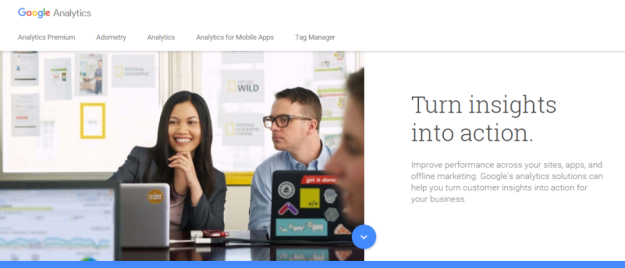
Google Analytics, just like with everything else Google has taken a huge chunk of market share. They currently boast about 63% of the total analytics market and none of their competitors come close. The raw data available can be a real help if you know what you’re doing.
Price: Free
Pros:
- Since it’s so widely used, there are many 3rd party tutorials detailing how to make the most of it
- Custom reporting is priceless when you’re trying to quickly filter out the metrics that are important to you on particular campaigns or time periods.
- Easy to install, most CMS have plugins or integrations that allow you to install the javascript on all your pages with the click of a button
- Segmentation is readily available
- One analytics account can host multiple users.
Cons:
- Unable to track forms and fields on your website
- Amount of information and features can be overwhelming for a beginner
- Can’t export raw data
Clicky

Clicky is a free and premium analytics service that many people use to avoid Google (for example: PBNs) or get easier to understand analytics data.
Price: free-19.99+
Pros:
- An interesting feature of Clicky is the ability to monitor up to five Keywords on Twitter and sort by different criteria EG hashtag, links, questions etc
- You can monitor visitors to your site in real time viewing the actions they’re taking, pages they are viewing, and of course, how they got there in the first place.
- After a visitor leaves a comment, you can track them by name the next time they come to your site using custom cookies.
Cons:
- Clicky can be slow at times so the real time visitor stats may be a little off.
- The event tracking ability is limited for now. You can’t track subscriptions such as RSS Feed.
- Funnel Visualization is poor
Chartbeat
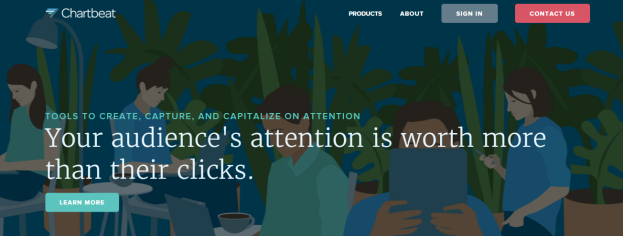
Chartbeat is a premium analytics tool that specializes in a few key areas
Price: $9.95 – $149.95
Pros:
- Great social media interface that lets you see how you’re performing and also allows you to add a twitter handle to monitor chatter.
- Gives you a clear picture of page loading times and how that affects your bounce rate
- Beautifully designed (although this has nothing to do with the functionality, it’s a nice adition by the developers)
- Can view visitors individually which can help you visualize your funnel in real time
Cons:
- Can’t visualize the places users are exiting your website from
- The social referrals does not break down the actual platform the visitors are coming from so you have no way of knowing which channel is actually working or not
- Some of the features don’t work all the time (beta) such as the rewind button which is supposed to allow you to look back at what happened on your site previously
- More of a lite tool rather than a full blown analytics suite
Woopra
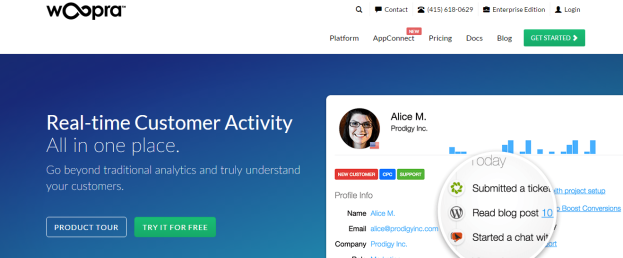
Woopra is a free and premium analytics tool that has a number of robust features will give everyone form the small blog owner to the enterprise user something of value.
Price: 0-$2000
Pros:
- Woopra has a robust customer service team and an extensive knowledge base to get you up and running.
- The tracking is almost scary. Every visitor to your site has a profile and you can view data on their life cycle. Every action they’ve ever taken on your site is available at your fingertips.
- Real time analytics allows you to open your dashboard and view exactly what’s happening when it’s going down.
- Android and IOS apps are available
Cons:
- The User experience can be overwhelming for newbies
- Third party integration is limited
- Limit of data of 90 days in the free version
- Data cannot be exported in an excel format
Mixpanel

Mixpanel says actions speak louder than page views. They are a free up to enterprise level analytics software that makes some pretty bold claims about their ability to help you get the most out of your users.
Price: 0-2000+
Pros:
- You can get in depth information about your funnel and where visitors commonly jump ship.
- Allows you to segment your analytics data to get a better picture of what is happening on your website.
- You can export the raw data! All of it.
Cons:
- Poor ecommerce tracking capabilities
- Can only see aggregate analytics over a period of three months.
- Setting up user flows is somewhat rigid (ie being able to map different paths a user takes when they come from a specific starting point).
- The reporting toos doesn’t allow you to make fully customizable reports EG you can see where they were referred from or where they live but you can’t see refers broken down by location.
GoingUp
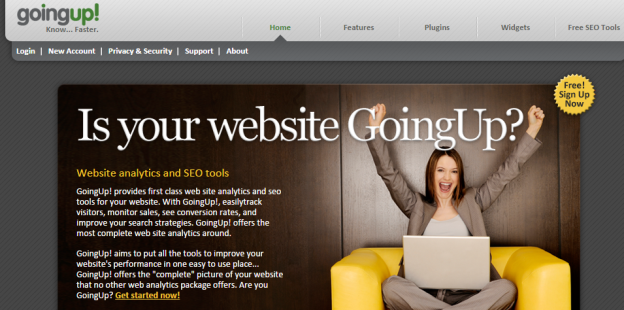
GoingUp! Is a lite analytics tool that is not really meant to be used as a stand-alone piece of software for your main site.
Price: Free
Pros:
- In addition to their analytics service, they provide users with free SEO tools to help optimize their site.
- Tracks Alexa ranking and formerly Page Rank for you in the backend so you don’t need to navigate to that site personally
- Heat maps let you drill down into what your visitors are clicking on your site
Cons:
- They insert ads on your website when it is loading
- They have a poor support team for when problems do happen to arise
- The backend interface can be slow to load at times.
Open Web Analytics
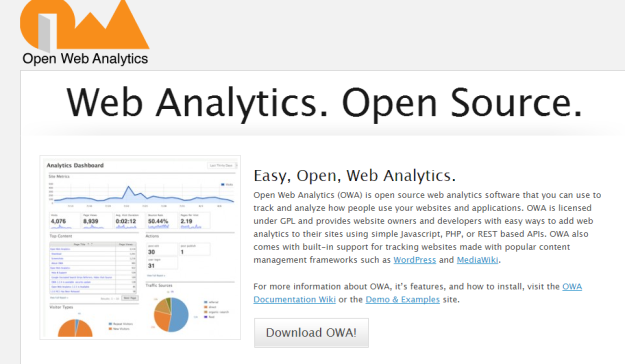
Open Web Analytics is an open source alternative to some of the pricier options out there.
Price: Free
Pros:
- It can track bot visits so it doesn’t skew your analytics data
- Robust reporting all the way down to the ISP
- Visitor flow track, geo segmentation, and custom event tracking are all possible with Open Web Analytics
- Data is stored in your database so ou can store it and use it however you like
- Heat maps are available so you can understand the elements of your page that people are interacting with
Cons:
- A big problem is that you don’t have the ability to export data from the user interface
- Cross segmentation is lacking. One piece of data cannot be viewed together with another piece of data
- It’s unable to track mobile devices which is a big problem since a huge chunk of internet users have gone mobile
Church Analytics
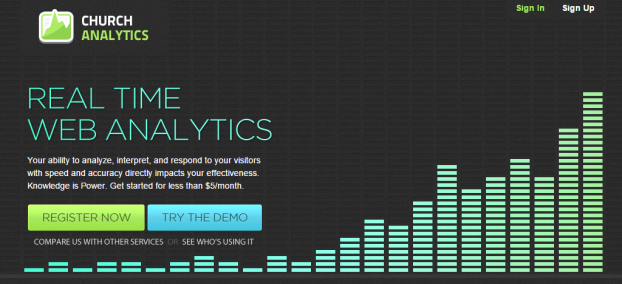
Church Analytics is a premium analytics tool that has an extremely low price point and tracks visitors from both desktop and mobile devices.
Price: 79/yr
Pros:
- Church analytics comes with a mobile app so you can monitor your website from anywhere in the world.
- They do a good job of fulfilling their promise of tracking visits to your site in real time, which can be helpful if you’re running a particular traffic campaign
- The dashboard is customizable so when you login you can instantly see a snapshot of what’s important to you.
- Seamless integration with ecommerce platforms so you can monitor the way your cart is performing.
Cons:
- Lacks the robust analytics features you’d expect in a premium software
FoxMetrics
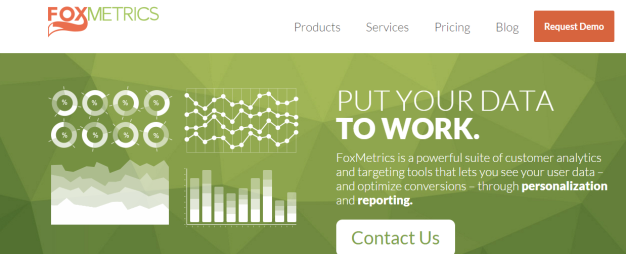
FoxMetrics was founded in 2010 with the idea of simplifying analytics software and allowing one user to handle all of the data needed to run a successful website.
Price: $20-$120 (cheaper if you pay yearly)
Pros:
- You’re able to drill down into your funnel to get an idea of where and why people are bouncing off your site
- High level of support, you can call in if you get overwhelmed with any of the features
- You can track almost every event on your website by setting up custom parameters
- Individual personalization for site visitors so you can envision the entire customer life cycle
Cons:
- A higher price point may make it prohibitive to you when trying to get the most out of the software.
- It takes a little getting used to and the knowledge base could be better
- Can’t track website speed and how it’s affecting your traffic and engagement.
Mint
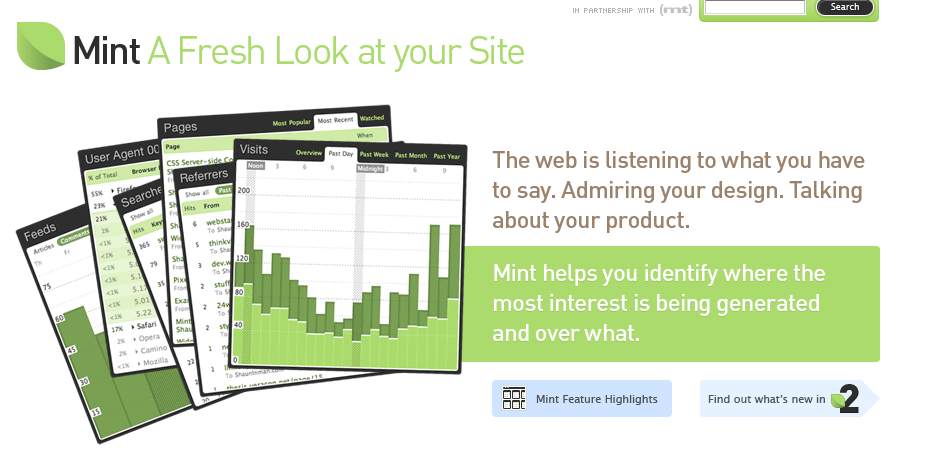
Mint is a straightforward self-hosted analytics solution. You can customize it to death or just use a few key features you find valuable.
Price: $30 per site
Pros:
- Easily able to prepare reports spanning days, weeks, or months
- You’re able to track multiple domains, events, and your website speed
- Track internal search so you know what users are looking for when they actually land on your site.
- Easily integrate with third party software for exporting and making beautiful reports
Cons:
- The data can be lacking when you want to run some in depth data comparisons
- They don’t have information about the location of your visitors which can be frustrating it you’re working with local businesses.
- Unable to track the time a user spends on your site
- The exporting feature does not include PDF or excel function which can really hamper your data analysis
Tools that Help tweak your site (A/B test) for Conversion Rate Optimization
I have to admit, I like A/B testing a lot more than other aspects of Conversion Rate Optimization because it’s so interesting.
Learning how certain colors, phrases, and headlines affect your conversion rates is truly priceless. Due to my love of tweaking, I’ve looked into A LOT of tools that will help you out no matter what your budget is.
Simple Page Tester
Simple Page Tester is a plugin that allows you to test multiple elements on a single page and is geared only towards WordPress Sites.
Price: 0 – $59
Pros:
- Easily integrates with goals in Google analytics
- You don’t need prior coding experience
- You can integrate custom short code (CSS) to test certain elements
- You can control the amount of traffic going to each variation through percentages
- Takes into account caching software so it won’t affect your results
Cons
- Only limited time for support and support is only through email
- If you don’t know a lot about code, it can be difficult to test individual elements on a page EG click through rate (CTR)
- Doesn’t support multivariate tests (you can only test two variations at once)
Nelio AB Testing
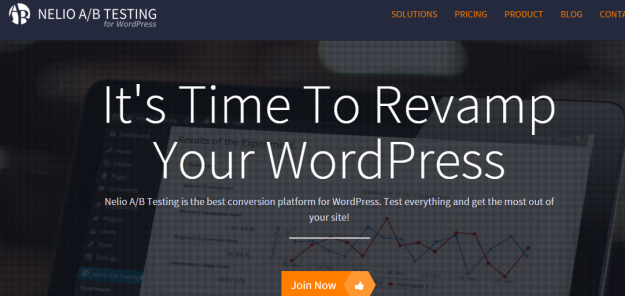
Nelio A/B Testing is a suite of testing tools made especially for WordPress sites which allows you to test a wide range of options without having to learn about coding.
Price: $29 – $259/m
Pros:
- You can test almost everything on your website using Nelio right from the beackend of your WordPress installation
- They have a built in heat map feature letting you know the most clicked on page elements
- You can compare two different themes side by side to get a feel for what your audience is reacting to the most.
- Easy to use and understand backend interface that allows you to quickly compare data
Cons:
- Limited number of impressions before you have to “buy” more
- The Plugin is free but you can’t use it unless you have an account with Nelio (it’s a bit misleading)
Optimizely
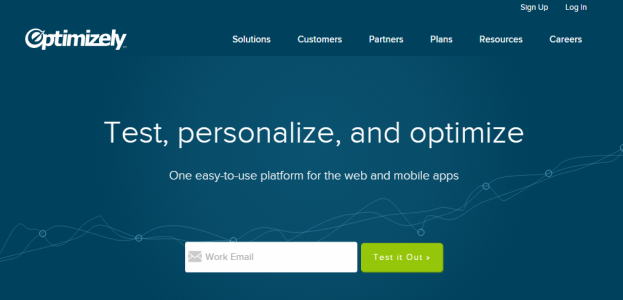
Optimizely is an industry leader when it comes to A/B testing and currently has over 10,000 users
Price: Free- Custom enterprise
Pros:
- Very easy to sync Optimizely with analytics account and they support a wide range of providers
- Comes with multivariate testing (test multiple page variations at once) be aware that this requires at least 10x more traffic
- Allows you to test different variations for desktop, mobile, and even tablet devices
- Editing features are easy to use for beginners and advanced users with knowledge of CSS and HTML can test advanced features to their hearts content.
Cons:
- Have a few weird default settings EG the analytics (data gathering) is automatically set to off
- Most of the best features are on the enterprise plan making it something out of reach for most users
AB Tasty
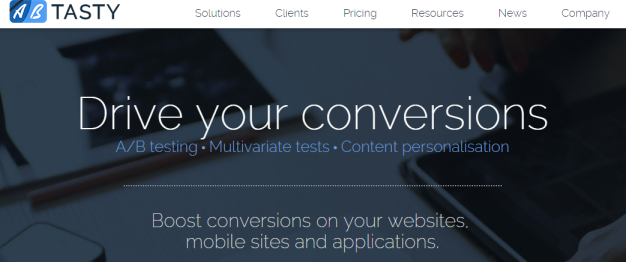
AB Tasty is a premium split testing tool that has been on the market for some time and is praised for the ease of use it offers users when setting up tests to optimize their websites.
Price: $34-$370+/m
Pros:
- The A/B Tasty team is always asking for and getting feedback from customers to make the tool better
- Advanced targeting options allow users to show pages based on referral or location
- A neat WYSIWYG editor comes in handy for quick changes
- Segmentation is readily available
- Multivariate testing allows you to test page elements over many variations
Cons:
- Sometimes, you need to write a limited amount of Javascript in order to implement some of your tests effectively
- It can lag sometimes (slow)
- The number of visitors with the lowest plan is rather limited for the price point (5,000)
- Segmenting traffic between a variation and a control page can be quite difficult at times
- There’s no contexttual help, EG a question mark next to some of the more obscure features to quickly guide you along
- Training materials could be more robust
Visual Website Optimizer
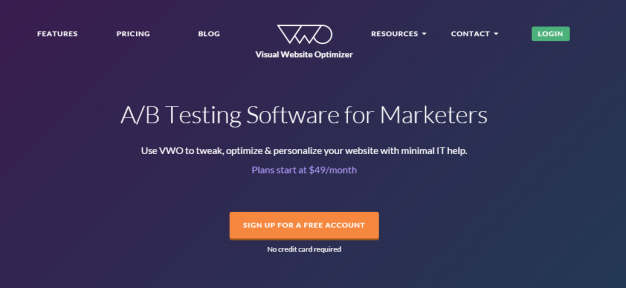
VWO is an A/B testing software built for marketers to make the most of their online real estate.
Price: $49-$999+
Pros:
- A/B Ideafox lets you search case studies of A/B tests for inspiration
- Built in in conversion suggestions you can use to improve your pages
- You can implement sitewide changes using VWO
- Visitor segmentation based on different variables EG search visitors
- Also comes with built in heat maps
Cons:
- VWO slows down page load times
- The VWO backend doesn’t support cross-referencing data and only allows you to look at one metric at a time
Unbounce
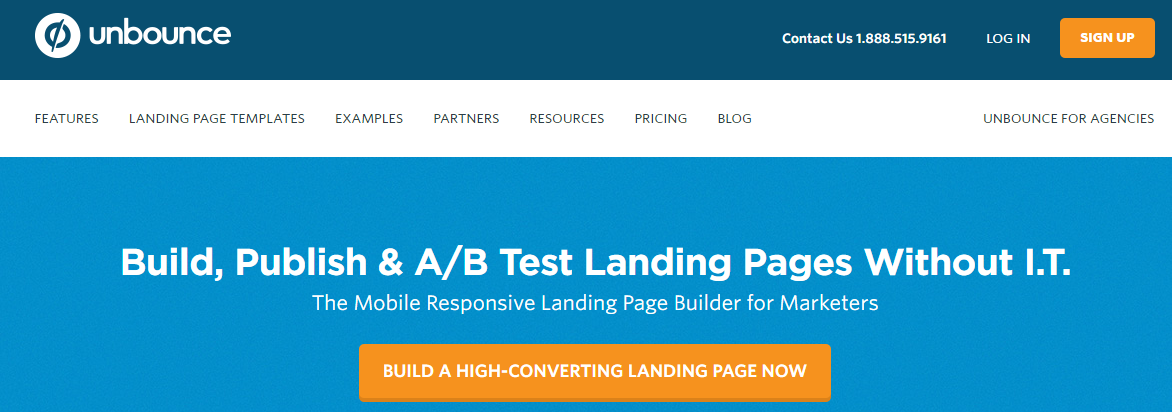
Unbounce is marketed as the ultimate landing page testing software for agencies.
Price: $49 – $199 (cheaper if billed annually)
Pros:
- An Easy to use WYSIWYG editor
- A few professional templates that you can tweak to suit your own needs
- A/B and multivariate testing
- Integrates easily with many third party software suites such as Salesforce, Aweber, Constant Contact etc.
- Cname Redirect from the Unbounce interface is quick and easy
Cons:
- Difficult to segment users with the tracking and analysis features. All you get are page views
- The editor is hyper sensitive. Sometimes moving elements when all you wanted to do was click on it.
- It can become tedious to manage changes across a large amount of landing pages
- Inserts ads on the free account
Crazy Egg
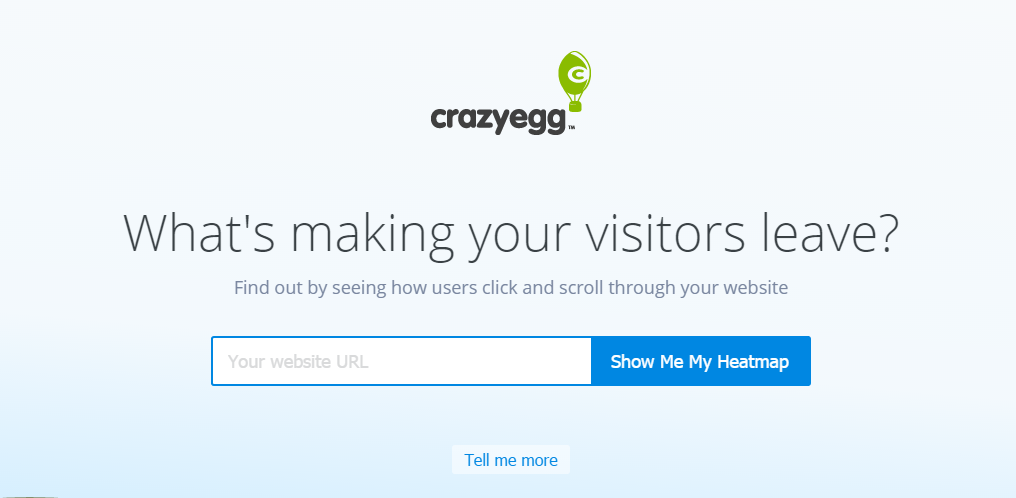
Crazy Egg is software that allows you to understand how people interact with elements on your pages. It comes with a host of features, but there are 4 that stand out. Heat maps, Overlay tools, Confetti, and scroll maps.
Price: $9 – $99 (billed annually)
Pros:
- A Neat overlay feature that allows you to look at the number of interactions/clicks on individual page elements.
- The proprietary feature called confetti allows you to look at all clicks to your website and distinguish the referral source, search terms, location and more.
- You can easily visualize the path visitors are taking in your funnel and it allows you to determine what you should tweak.
- Built in segmentation features for new and returning visitors
Cons:
- API integration with other third party software is limited
- Crazy Egg can’t be used as a standalone A/B testing solution
- Exporting features are limited to PDF and images
- The interface can definitely use some improvement for a better user experience
Qeryz
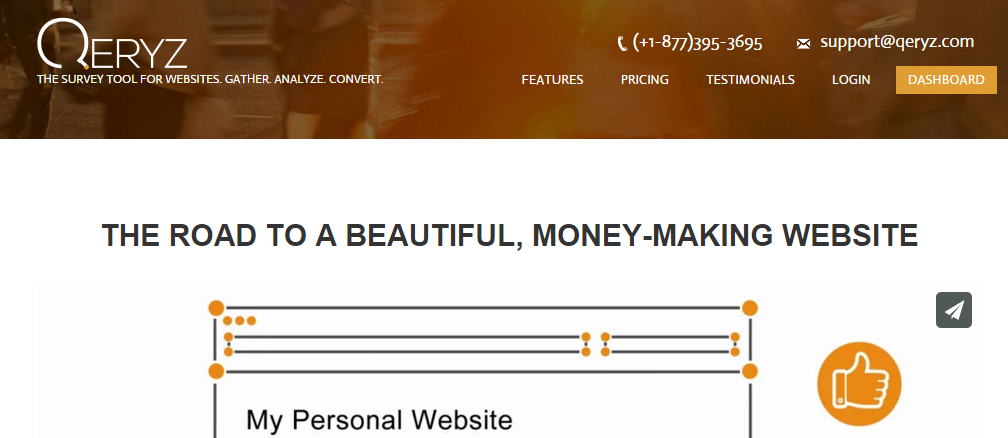
Price: Free – $79 month
Qeryz is a unique conversion rate optimization program because it focuses on exactly what your users want. Instead of testing one hundred variations, you can do something very few webmasters can, ask.
Pros:
- There are many different options to choose from with Qeryz. You can use it to increase your subscription rate, ask structured questions, give surveys, and much more.
- The Qeryz popup is customizable based on color and design
- You can also segment the targeting features so those that landed on your site from Facebook can get a different experience from those that came from the search engines
Cons:
- There is no way of filtering spam out of the responses so responses can be irrelevant at times.
- After the surveys is minimized, it stays minimized – although that may not be so much of a con since Qeryz was designed to be as unobtrusive as possible
A Final Note
These are the best tools out there to help you get the maximum use out of your digital properties. I encourage you to try them a few of them out yourself to see which one works best for you and your goals.
After that, test, test and test some more until you get the maximum conversions possible. Nothing is proven until you’ve tested it yourself.
You can get my personal A/B Case study swipe file here.
